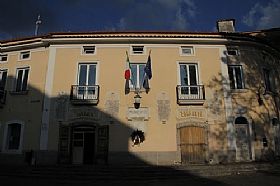Montemarano

The wild, inland area of Campania is called Irpinia, a district of woods and ancient traditions that offers a glimpse of Italy outside the normal tourist sights. Here, in towns like Montemarano, normal daily life goes on as always, allowing one to really immerse in the culture and participate in the authentic festivals; in other words, you can go beyong being "a tourist" to being a participant!
Montemarano has ancient roots, starting with the ancient Samnites people, who fought the Romans when they arrived in Campania. In fact, the entire eastern part of Campania is still referred to as "the Sannio" because it had been the land of the Sanniti. Irpinia is used to designate the zone around Avellino, and the wine production area of some of Campania's most noteworth wines: Fiano di Avellino, Greco di Tufo, and Taurasi DOCG.
Montemerano was taken by the Romans, then subsequent invaders included the Barbarians, Byzantines, and Lombards; each were strongly and arduously resisted by the local population, and their fierce territorial pride continues today. They jealously hold to their traditions and rites.
There are some interesting festivals here. The Festa del Vino is a big affair considering the area's vintages, held at the end of September/beginning of October annually. The woods are full of chestnuts, mushrooms, and truffles, so there is a festival dedicated to the woodlands produce, the Festa del Bosco, every August. One of Montemarano's most fascinating traditions, though, is the Tarantella. This mystic rite dates back many centuries, the rhythmic music and frenetic dance was used as a cure and a purification ritual. The town is famous for their tarantella montemaranese, which is also incorporated into the Carnevale festivities. There is an ethno-musical museum in town dedicated to this form of rural music, as well as a school of tarantella. The Carnevale of Montemarano is famous throughout the area.
An interesting and unusual museum here is the one that displays sacred "paramenti" - liturgical vestments, which were created in southern Italy from the 16th century through the 20th century. It is located in Piazza Mercato.
Don't miss the Cathedral, which was built over a Roman temple. The construction is one of the few example of Norman architecture in Campania. Even though it was remodeled in the 1700s, it retains the ancient columns and elements. Of particular note are the ancient fresco fragments in the crypt. There is also some notable art, including a painting by Guido Reni. A local legendary event is found depicted in the Basilica of Saint Francis in Assisi, painted and immortalized by Giotto, called "The Miracle of the Death in Montemarano" (also called The Confession of the Resuscitated Woman); apparently a local noble woman had died, but was raised again by St. Francis so that she could confess before entering eternity.
Montemarano is situated in the province of Avellino, and despite its location in the Apennine Mountains, is less than an hour from Salerno and the start of the Amalfi Coast. It is just over an hour to Naples.
Enjoy the comfort of a vacation home in Campania.

 Amalfi Coast
Amalfi Coast Sorrento Coast
Sorrento Coast Tuscany
Tuscany Cilento National Park
Cilento National Park Lake Como
Lake Como Rome and Latium
Rome and Latium Umbria
Umbria Capri and Ischia
Capri and Ischia Venice
Venice Puglia (Apulia)
Puglia (Apulia) Liguria
Liguria Sicily
Sicily Lake Maggiore
Lake Maggiore Lombardy
Lombardy Sardinia
Sardinia Lake Garda
Lake Garda Abruzzo and Marche
Abruzzo and Marche Calabria
Calabria

